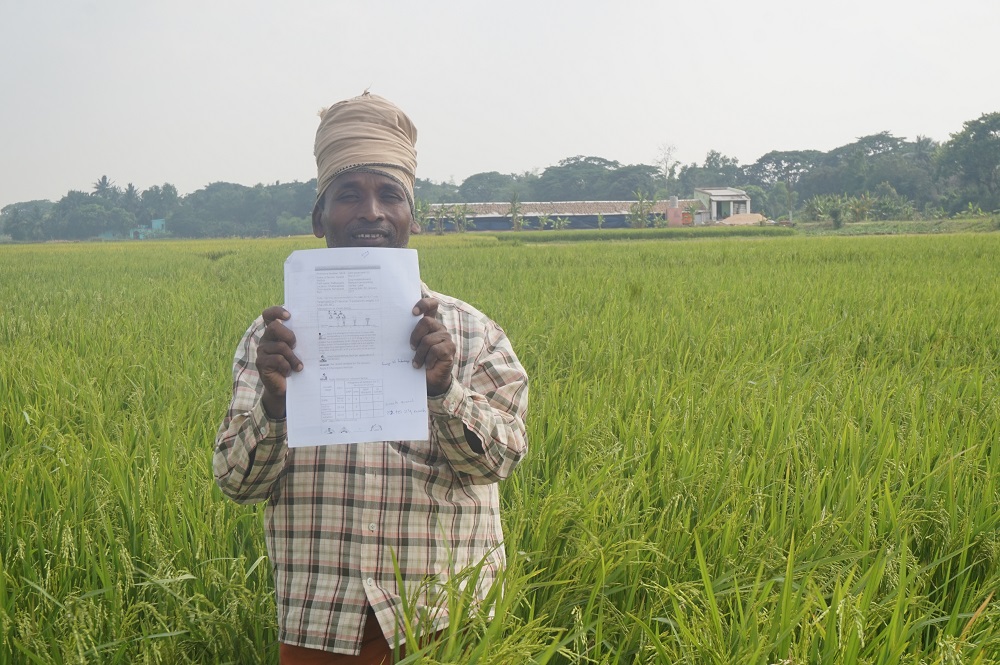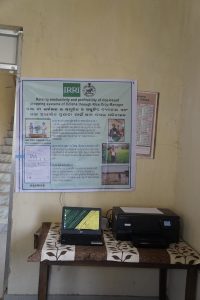Given the wide variability of farms across India, the Rice Crop Manager (RCM) is providing management recommendations tailored to each farmer’s field.

In Odisha, rice is synonymous with food. Out of the total arable land area of 5.8 million hectares (ha), rice is grown on 4.5 million ha (around 77%) of both rainfed and irrigated areas. However, average productivity is only 1.8 tons/ha, which is below the national average of 2.4 t/ha. The major constraints in rice production in the state are flood, drought, and salinity, along with poor crop management practices.
Further, because of the lack of awareness of better crop management practices, farmers continue to use traditional farming practices passed on from generation to generation. This has resulted in improper use of fertilizers and pesticides that, in turn, increased the cost of cultivation but with low productivity and degradation of soil fertility.
Farm-level technology
In the 1990s, the International Rice Research Institute (IRRI), in collaboration with partners across Asia, developed the site-specific nutrient management (SSNM) approach. SSNM gives rice farmers guidelines for applying the right amount of essential nutrients for their crops at the right time. Compared with existing fertilizer practices, SSNM-based fertilizer recommendations for rice have been proven to increase yield and net income of farmers as well as provide positive impacts on the environment.
Using the principles of SSNM, IRRI developed Rice Crop Manager (RCM), an application that provides farmers with crop management recommendations tailored to their field and rice-growing conditions through the internet, toll-free numbers (already available in the Philippines), and text messages (soon to be launched in India). In addition to nutrients, RCM addresses other constraints that limit rice yield and farmers’ profit. These constraints can vary across areas, growing conditions, varieties, and climate scenarios.
RCM in Odisha
RCM was introduced in Odisha in 2013 under the Cereal Systems Initiative for South Asia (CSISA) project. It was developed, adapted, evaluated, and verified in partnership with the National Rice Research Institute and Odisha University of Agriculture and Technology.
RCM was identified as an important tool for increasing the profitability of farmers through improved nutrient-use efficiency and better crop management. When RCM was tested in farmers’ fields, it produced about 1 t/ha more in rice yield than with traditional fertilizer application. In terms of income, there was an increase of USD 188 per ha per season.
In 2015, IRRI and the government of Odisha signed a memorandum of understanding to increase the productivity of rice-based cropping systems and enhance farmers’ income in the state through the implementation of the project Increasing Productivity of Rice-based Cropping Systems and Farmers’ Income in Odisha.
One of the aims of a subproject is to increase the productivity and profitability of rice farming throughout the state’s rice-growing areas using RCM, train various stakeholders in using ICT-based tools, and expand the capabilities of RCM for irrigated and rainfed environments to include in-season corrections.
More than a thousand extension workers of the state’s Department of Agriculture in seven districts have been trained in using the RCM application. They are providing RCM recommendations to farmers at their doorstep and encouraging them to follow the advisory throughout the season. Many nongovernment organizations (NGOs) with agricultural and livelihood mandates have also partnered with IRRI and are working to disseminate RCM recommendations among farmers.
“I applied fertilizers as per the RCM recommendation on half of my land and on the other half I applied fertilizers as per my usual practice,” said Mr. Kartik Samal, a farmer from Bhadrak District.
“In the RCM plot, the yield was higher by 1.2 tons and there was a cost saving of about USD 18 per ha because fewer fertilizers were applied.” Mr. Chandra Swain, a farmer from Puri District, also benefited from RCM. “Earlier, I used to apply split doses of fertilizer by guessing the crop stage,” he said. “But the RCM recommendation guides me with the correct time for top dressings.”
Approximately 44,000 farmers have received RCM recommendations for their rice crop since 2016.

RCM kendras
Under the project, RCM kendras (centers) are being established at block agricultural offices across the state to provide one-stop information hubs for nearby farming communities. These kendras are equipped with ICT devices used by trained extension staff of the DoA to provide RCM recommendations to the farmers. Efforts are being made to popularize these kendras among farming communities and encourage farmers to visit them before the start of each cropping season to receive personalized recommendations for their rice crop.
Beyond rice
In Bihar and eastern Uttar Pradesh, farmers generally follow a rice-wheat or rice-maize cropping system. In view of these cropping systems, RCM was modified to create the Crop Manager for Rice-Based Systems (CMRS) under CSISA. IRRI developed CMRS in collaboration with Bihar Agricultural University, Rajendra Agricultural University, Indian Council of Agricultural Research-Research Complex for Eastern Region, and Banaras Hindu University.
Endorsed and released by the union agriculture minister for Bihar farmers in 2016, CMRS is being disseminated through Krishi Vigyan Kendras (KVK), NGOs, and private service providers. IRRI is responsible for training KVK scientists, NGOs, and service providers.
To date, thousands of CMRS recommendations have been generated and provided to the farmers.
The way forward
RCM is a work in progress and is continuously undergoing refinements and upgrading to make it even more farmer-friendly. IRRI is working with weather forecasting agencies to include weather-based advisories to help farmers receive real-time information on crop and nutrient management based on local weather conditions. The effects of this intervention are expected to occur in the next few cropping seasons.
Considering the wide variability of farms across India, the “one size fits all” approach is not an appropriate strategy for change. By providing farmers with personalized recommendations, this could help them make better decisions that, in turn, will lead to improved fertilizer use, balanced nutrient application, and higher agronomic efficiency.
__________________________
Dr. Sharma leads IRRI’s soil research in South Asia. Dr. Mishra leads IRRI’s soil science team in India. Ms. Bharti manages training and communication of IRRI-Odisha projects. Ms. Anand manages IRRI projects in South Asia.







Thanks to irri for improving Indian farmers and helping them to improve their farming….